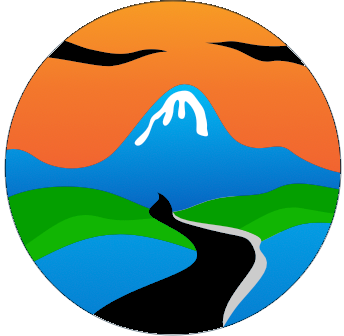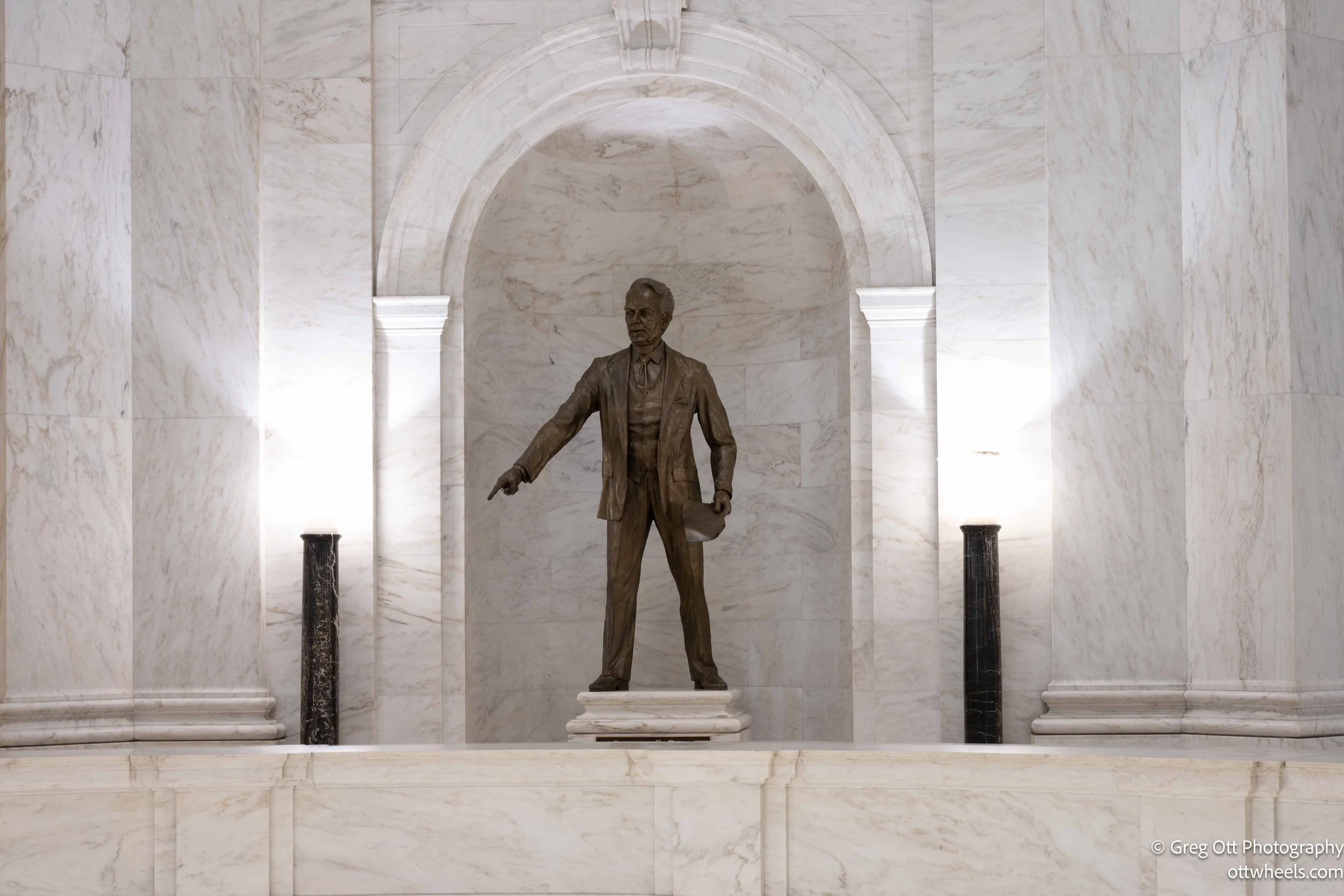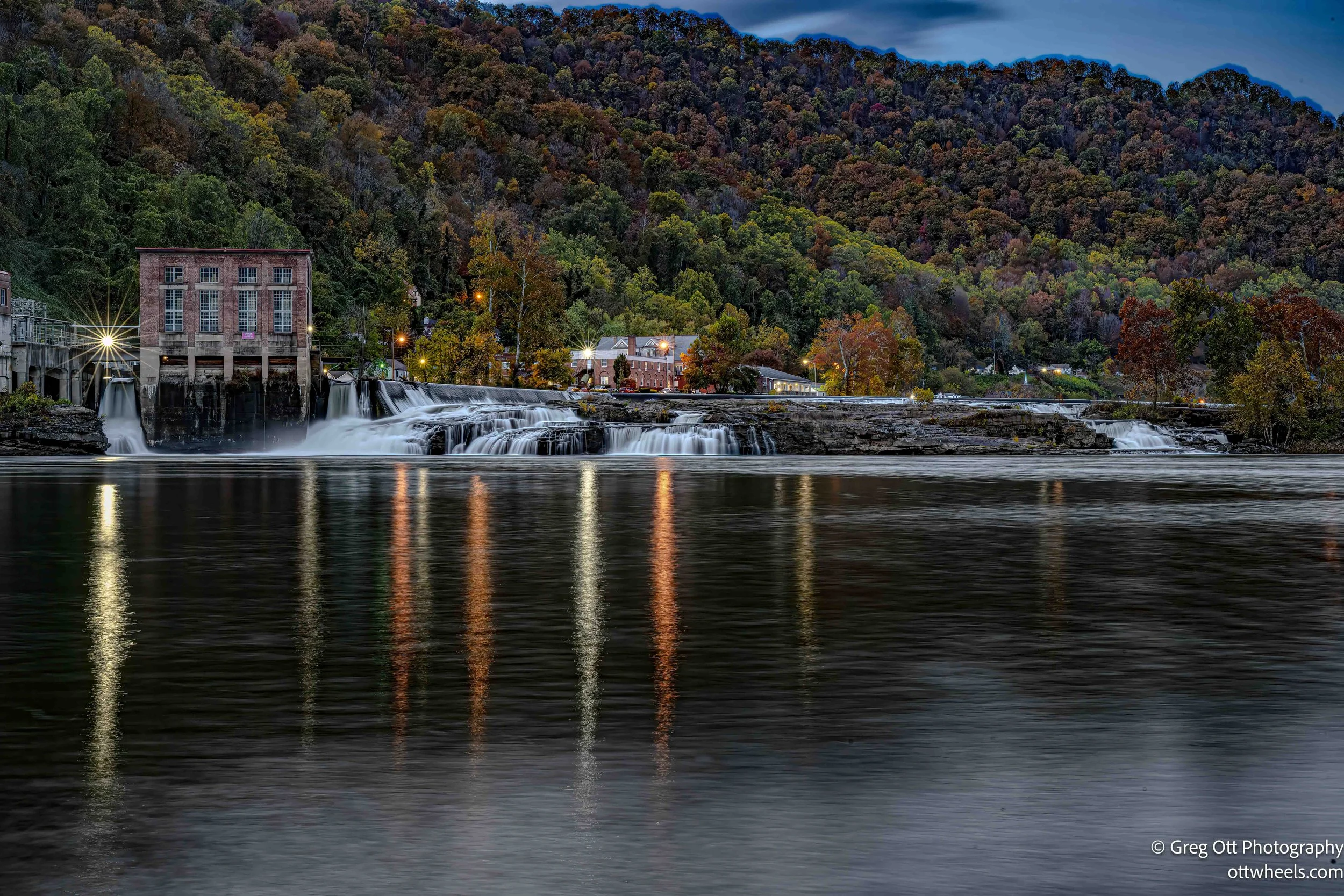Charleston, WV
The drive into the Charleston takes you across a bridge and some very tight turns (for a van) to get to the Capitol Complex. The town seemed very quiet for a late Saturday morning. There were a few joggers along the river.
I parked in a metered spot beside the museum (free on the weekend), but there were no signs pointing to the museum entrance, and Google Maps sent me the wrong way. I ended up walking a full circle around the building before finally finding a door. Admission was free, and the staff at the front desk said photography was fine—just no flash.
West Virginia State Museum
The West Virginia State Museum in Charleston turned out to be far more interesting than I expected. It’s laid out as a walk through time—literally. The exhibits follow a path that winds through the state’s story, beginning long before West Virginia existed, when the region was still part of Virginia. Each section is arranged by era, so as you move forward, the lighting, flooring, and even the sounds change to match the period. It’s an immersive experience that makes the state’s history feel less like a collection of artifacts and more like a lived journey.
The most powerful section, at least for me, was the part explaining how West Virginia broke away from Virginia during the Civil War. It wasn’t just a geographic split—it was political, cultural, and deeply personal. Western Virginia’s mountain counties were poor, sparsely populated, and built on small farms, while the east relied on large plantations and slavery. When Virginia voted to secede from the Union in 1861, many in the west refused to go along. They held their own convention in Wheeling and declared loyalty to the United States, forming a “Restored Government of Virginia.” In 1863, that effort became official when West Virginia entered the Union as a separate state—the only one created by seceding from a Confederate state.
As the museum’s timeline continues, you move into the state’s industrial age: timber, railroads, and above all, coal. The exhibits show how those industries shaped both the land and the people—boomtowns rising and falling, families building entire lives around a single company mine. Along the way, you meet the people who gave the state its voice and grit: coal miners, musicians, glassblowers, veterans, and teachers. There are displays on Pearl S. Buck, Chuck Yeager, Mary Lou Retton, Jerry West and others who carried pieces of West Virginia into the wider world.
By the time I stepped out of the last room, I felt like I’d been through more than a museum. It told the story straight—no gloss, no fancy language—just how this state came to be. You could see how much of West Virginia’s identity was shaped by the land itself: the isolation of the mountains, the small towns that grew up around the mines, the pride that comes from hard work and tough conditions. It’s easy to think of history as something distant, but here it feels close, almost familiar. You walk out realizing this state was built by people who just kept going, no matter what was thrown at them.
Veteran’s Memorial
After the museum, I headed back to the van for lunch. On the way, I passed the West Virginia Veterans Memorial. The circular stone structure sits quietly on the Capitol grounds, framed by open arches and a shallow pool that reflects the sky. Names of more than 10,000 West Virginians who died in twentieth-century wars are etched into the walls. The design is simple and understated, but standing there, it feels solemn and grounded—a place built for quiet reflection rather than display.
West Virginia Capitol
After lunch, I walked back to the West Virginia State Capitol. It was a quiet Saturday. I talked with a security guard about tours, but he told me they don’t offer them on weekends. There weren’t any self-guided pamphlets available either. I was on my own to explore the grounds and the building. I decided to first walk the grounds and take photos of the dome. The gold leaf at the top shimmered in the sunlight—it’s an impressive sight, towering over the rest of the complex and visible from nearly every angle on the grounds.
In front of the State Capitol stands a bronze statue of Abraham Lincoln, seated with an open book in his hand. It’s called Lincoln Walks at Midnight, modeled after a poem that imagined him restless and burdened by the cost of war. Lincoln holds a special place in West Virginia’s history—he signed the proclamation that officially created the state in 1863, after the northwestern counties broke away from Confederate Virginia during the Civil War. The statue faces the Capitol dome, a quiet reminder that without Lincoln’s decision, West Virginia might never have existed as its own state.
Capitol Inside
I went back to the weekend entrance and wandered through the main hall. Both legislative chambers were closed, so there wasn’t much access beyond the central area. The only part really worth seeing was the rotunda. The marble, the symmetry, the way sound carries through that high space—it all feels grand, though a bit formal.
One of the guards was passing by on the other side of the rotunda and I said hello. He asked, “Are you getting any good pictures?” I told him I hoped so. We ended up talking for about thirty minutes. He had been the police chief in a small town south of the capital and knew a lot about the building’s history. The murals around the rotunda had been repainted in the last few years—something I hadn’t realized. I thought they had just been cleaned because of how bright and fresh they looked. Before I left, he pointed out the statue of Robert C. Byrd in the center of the Capitol.
Robert C. Byrd’s name is in many places across West Virginia. His statue stands as a reminder of how deeply his legacy runs through the state. Byrd served more than fifty years in Congress and was known for securing federal support that helped build schools, hospitals, and roads across West Virginia. But the statue is controversial because of Byrd’s early membership in the Ku Klux Klan—a part of his life he later denounced and called his greatest mistake. Some believe the statue should be removed because of that past, while others argue it should remain as part of the state’s complex history. Standing there, I found myself thinking about how difficult it can be to reconcile a person’s full story—the harm they caused and the good they later tried to do.
I was getting ready to leave and saw a woman with a booklet about the capitol building. I asked her where she got it and she handed me one and said there were two her at the information desk. She then told me about an exhibition on the third floor and gave me directions (take the elevator to the third floor, turn right, etc.). There was no third floor and right led to several locked offices. I continued the search and never found the exhibition.
I planned to have dinner at 1010 Bridge, a restaurant on the other side of the river and up a steep hill. Parking was impossible. The spaces were either too narrow for the van or reserved for nearby restaurants and businesses. It would have been the perfect ending to an already interesting day. After thirty minutes of circling the area, I gave up and headed toward Fayetteville, West Virginia.
Kanawha Falls
I had Cathedral Falls on my itinerary for the day, but I thought it would be too dark to photograph. Kanawha Falls in Glen Ferris, about a mile away, was right along the road, so I stopped to take a few long-exposure shots of the falls from a distance.
I reached a trailhead I had found through an app. I was about 8 p.m. when I drove down the dirt road. Unfortunetly, there was a truck and a car already parked at the end of the narrow, single-lane road. There wasn’t enough room to turn around, so I had to back out for nearly half a mile. The rear camera made it manageable; without it, it would have been nearly impossible in the dark. Once back on the main road, I checked my map and saw a Walmart about fifteen minutes away. That’s where I ended up for the night. It was loud at first—trucks idling, a few cars coming and going—but eventually the noise faded, and the lot turned still and quiet.




























